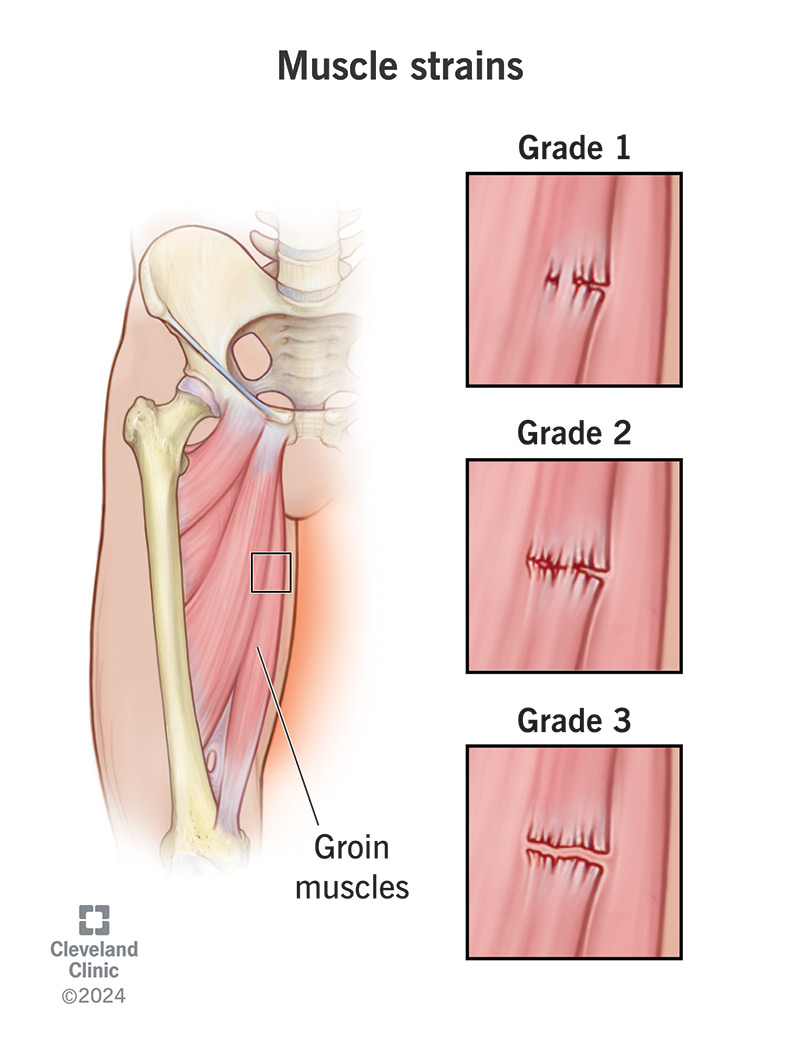Muscle strains (pulled muscles) are common but painful injuries. You can often treat a pulled muscle at home. But not all strains are alike: A severe tear might need medical care or even surgery. Follow your healthcare provider’s advice to ensure a smooth recovery.
Advertisement
Cleveland Clinic is a non-profit academic medical center. Advertising on our site helps support our mission. We do not endorse non-Cleveland Clinic products or services. Policy

A muscle strain, or pulled muscle, is a tear in your muscle fibers. It’s one of the most common soft tissue injuries. You can strain a muscle by pulling it too hard or using it too much, which weakens the fibers.
Advertisement
Cleveland Clinic is a non-profit academic medical center. Advertising on our site helps support our mission. We do not endorse non-Cleveland Clinic products or services. Policy
Muscle strains can be minor to major. A mild strain might only break tiny fibers within the fabric of your muscle, while a severe one can tear through it. Strains are painful, but most can heal with time and rest.
Your muscles are made of thousands of small fibers woven together. When you strain a muscle, the strands of fiber are stretched beyond their limit and tear apart. If you’ve ever tried to use an old bungee cord to hold something in place, you’ve seen this happen. New bungee cords have plenty of give and stretch. But if you use one for too long or suddenly jerk on it too hard, the fibers will start to pull apart.
Common types of muscle strains include:
Healthcare providers also classify muscle strains as either acute or chronic.
Symptoms of a pulled or torn muscle include:
Advertisement
A torn muscle feels sore when you try to use it. You can usually locate the pain in one spot. You may be able to connect it to a recent event or activity. If it’s a chronic muscle strain, you may develop pain gradually over a few days. If it’s an acute muscle strain, you’ll feel pain immediately, and it may even feel like tearing. You may also feel your muscle weaken, and you may feel that you can’t use it at all.
Muscle strains happen when you tear the fibers of your muscle. This can happen suddenly or gradually.
Common causes of muscle strains include:
Some muscles are more likely to tear than others. These are muscles that:
Other risk factors that can contribute to muscle strains include:
If you’ve pulled a muscle, you’ll probably have a pretty good idea of how it happened. A healthcare provider will start by asking you about when the pain started and what you were doing at the time. Then, they’ll examine the spot, which may have visible bruising and swelling if it’s been at least 24 hours since the injury. They’ll gently feel it for tenderness and test the muscle for strength and range of motion.
Advertisement
A physical exam is often enough to diagnose a pulled muscle. But in some cases, your provider might want to take an MRI to rule out other conditions, or to determine the extent of the tear and grade it.
Healthcare providers also grade muscle strains by how severe they are.
Most people can recover from a pulled muscle at home. Only a severe, grade III tear might need surgery. Surgery for a complete muscle tear means stitching the two ends of the muscle back together.
Home treatment for a muscle strain includes:
Advertisement
Check in with a healthcare provider if your muscle strain:
You might want to ask:
If you only have a minor (grade I) muscle strain, it should heal within a few weeks. Moderate (grade II) muscle strains may take several weeks to months to heal completely. A severe (grade III) muscle strain can take four to six months to heal after surgery. You may need to immobilize your muscle with a cast for up to six weeks before starting your rehabilitation program. Athletes will need to sit out the season.
Most people recover completely from a muscle strain, even a severe one. But how you treat your muscle during recovery can affect how well it heals. In some cases, the muscle might retain some scar tissue, which is stiffer and more brittle than healthy muscle tissue. This makes it easier to tear the muscle again. You might have to be more mindful of how you use your muscle in the future.
Advertisement
Some simple guidelines to help prevent muscle strains are:
Pulling a muscle is painful. For some, the frustration of having to sit out of your favorite sports and activities while you recover can be just as difficult. But your muscle needs time to heal, and it needs your patient attention during the rehabilitation process. Giving yourself that time is the best way to ensure you’ll be able to return safely to doing what you love to do, at the intensity level you’re used to.
From sudden injuries to chronic conditions, Cleveland Clinic’s orthopaedic providers can guide you through testing, treatment and beyond.

Last reviewed on 02/18/2025.
Learn more about the Health Library and our editorial process.